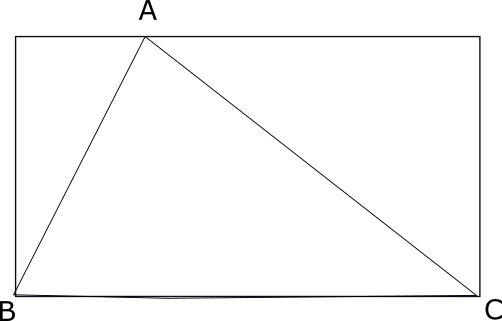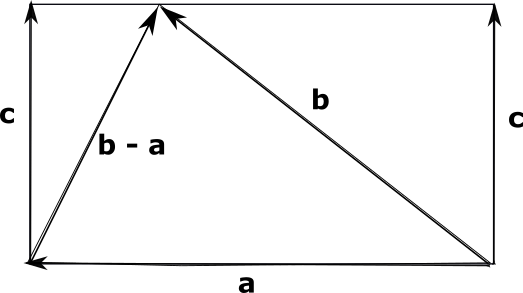Abstract: We show how to prove that a triangle inscribed in a rectangle has
half the area of the rectangle by using vectors and geometric algebra.
Download PDF file: Area of Inscribed Triangle
I recently saw a demonstration of how to prove that a triangle inscribed in a rectangle,
as given in the Figure 1, has half the area of the rectangle. The proof used there was
by Euclidean geometry. The point $\bA$ in Fig. 1 is anywhere on the top of the rectangle.

Figure 1. By dropping an altitude from $\bA$ to $\bB\bC$, it's easy to see that
the area of the triangle is half the area of the rectangle, though a formal
proof in Euclidean geometry would still be needed.
Using the methods of Geometric Algebra, we'll produce the same result.

Figure 2. Now that the vectors are conveniently assigned, we can
find areas by taking wedge products. As always, the total is the sum
of its parts.
Point 1. The reader who is not familiar with geometric algebra and wedge products,
can reference on-line sources through the search string 'wedge product'. The main reference book is
New Foundations for Classical Mechanics by David Hestenes (Kluwer Academic Publishers).
An online reference is
Download PDF file: A Geometric Algebra Primer by David Hestenes
Point 2. The area of a triangle is typically computed by taking half the wedge product of
any two sides. So, the area of the inscribed triangle in Fig. 2 is
Point 3. In general, the area of a rectangle (or any parallelogram)
is computed by taking the wedge product of any two adjacent sides (as vectors) of
the rectangle. Areas in this system are represented by bivectors, which can have
either positive or negative orientation -- positive if it has a counterclockwise
orientation. (This convention seems to be consistent with that of contour
integrals in complex analysis.) Hence, the area of the rectangle in Fig. 2 is given by
\begin{equation}
\text{Area}\ \sqsubset\!\sqsupset\ =\ \ba\wedge\bc\,.\label{eq:a_wedge_c}
\end{equation}
Point 4. Note: For any two vectors $\ba$ and $\bb$, $\ba\wedge\bb = - \bb\wedge\ba$.
Now we find the area of the rectangle as the sum of its parts (always choosing the same orientation for each bivector area segment): \begin{align} \text{Area}\ \sqsubset\!\sqsupset &= \frac{1}{2}\ba\wedge\bb + \frac{1}{2}\bc\wedge(\bb-\ba) + \frac{1}{2}\bb\wedge\bc \notag\\ &= \frac{1}{2}\ba\wedge\bb + \frac{1}{2}\bc\wedge\bb - \frac{1}{2}\bc\wedge\ba + \frac{1}{2}\bb\wedge\bc \notag\\ &= \frac{1}{2}\ba\wedge\bb - \frac{1}{2}\bc\wedge\ba\quad\text{(after cancellation)} \notag\\ &= \text{Area of Inscribed}\ \triangle + \frac{1}{2}\text{Area} \sqsubset\!\sqsupset\,. \end{align}
Hence, we get \begin{equation} \text{Area of Inscribed}\ \triangle = \frac{1}{2}\text{Area}\ \sqsubset\!\sqsupset\,. \end{equation}
QED